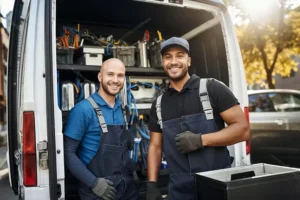Winter can be a challenging time for homeowners, especially when it comes to protecting plumbing systems from the harsh cold. Frozen pipes are a common issue during winter, leading to burst pipes, water damage, and costly repairs. As the water inside the pipes freezes, it expands, causing pressure to build up, which can lead to cracks and bursts in the pipes. At Polar in Collinsville, IL, we’re your trusted plumbing, heating, and cooling experts, ready to help you prepare your home for the cold months ahead. In this blog, we’ll share essential plumbing tips to avoid winter freezing and keep your home’s water system functioning smoothly throughout the season.
Insulate Exposed Pipes
The first and most important tip is to insulate any exposed pipes. Pipes that are in unheated areas, such as basements, attics, garages, or crawl spaces, are especially vulnerable to freezing temperatures. Wrapping these pipes in insulation helps prevent them from freezing when the temperature drops. You can use foam pipe insulation, fiberglass wrap, or even heat tape for this purpose. Insulation creates a protective barrier that keeps the warmth inside the pipes, reducing the chances of freezing. Properly insulated pipes are less likely to burst, which helps prevent water damage to your home’s walls, ceilings, and floors. Not only does this save you from unexpected repairs, but it also helps maintain the efficiency of your plumbing system during the winter.
Seal Cracks and Gaps
Cold air can seep into your home through small cracks and gaps, particularly around windows, doors, and where pipes enter the house. This cold air exposure can cause pipes to freeze quickly, especially in areas where pipes are already exposed or poorly insulated. To protect your plumbing system, it’s essential to seal any cracks, gaps, or holes where cold air could infiltrate. Use caulk or weatherstripping to seal any potential entry points. Pay special attention to the areas where pipes run through exterior walls or floors. By sealing these cracks, you’re not only preventing cold air from reaching your pipes, but you’re also helping to maintain a warmer indoor environment, which can reduce your overall heating costs. This is a simple yet effective way to minimize the risk of frozen pipes during the winter months.
Let Faucets Drip
A small, steady drip from your faucets can help keep your pipes from freezing during extremely cold weather. When water moves through the pipes, even at a slow pace, it’s less likely to freeze. This tactic is especially useful for pipes located along exterior walls or in unheated parts of the home. Allowing both hot and cold water to drip slightly helps relieve pressure inside the pipes, which can prevent them from bursting even if they do freeze. The cost of a slow-dripping faucet is far less than the cost of repairing a burst pipe. It’s an easy preventive measure that keeps your plumbing system protected during freezing temperatures. Just make sure to open the faucet enough to let a tiny trickle of water flow continuously overnight, especially when temperatures are at their lowest.
Disconnect and Drain Outdoor Hoses
Leaving garden hoses attached to outdoor faucets during winter is a common mistake many homeowners make. When temperatures drop, any water left in the hose can freeze, causing pressure to build up in the outdoor faucet and connected pipes, potentially leading to a burst. To prevent this, disconnect all garden hoses from outdoor faucets before the first freeze. Once disconnected, drain the hoses and store them inside for the winter. Additionally, consider installing frost-proof outdoor faucets or placing insulating covers over them for extra protection. Draining and securing your outdoor water sources is a quick, proactive step that can save you from major plumbing headaches down the road.
Keep the Heat On
If you’re planning to be away from home during the winter, it’s crucial to keep your thermostat set to a consistent temperature. Never let your home’s indoor temperature drop below 55 degrees Fahrenheit, even if no one is there. This ensures that the pipes inside your home stay warm enough to prevent freezing. In addition to maintaining your home’s temperature, it’s a good idea to open cabinet doors under sinks and vanities to allow warm air to circulate the pipes. This is especially important for pipes located along exterior walls, where the cold can penetrate more easily. Keeping your home’s heating system running steadily throughout winter helps protect your plumbing and ensures your home stays comfortable and safe. For more helpful tips, you can contact Polar any time.
Trust Our Polar Experts to Keep You Warm This Winter
By following these simple yet effective plumbing tips, you can greatly reduce the risk of frozen pipes and avoid the costly damage that can come with them. Insulating exposed pipes, sealing cracks, allowing faucets to drip, disconnecting hoses, and maintaining a steady indoor temperature are all proactive steps that keep your plumbing system protected during winter’s coldest months.
However, if you experience any plumbing issues or need assistance preparing your home for the winter, don’t hesitate to contact Polar in Collinsville, IL. Our team of expert plumbers, heating, and cooling specialists is here to provide you with reliable, high-quality service to ensure your home remains safe, warm, and free from plumbing problems all season long. Reach out to us today for a consultation or to schedule preventive maintenance for your plumbing system. Call 618.772.7007 now. Stay warm, and let Polar keep your pipes protected!













